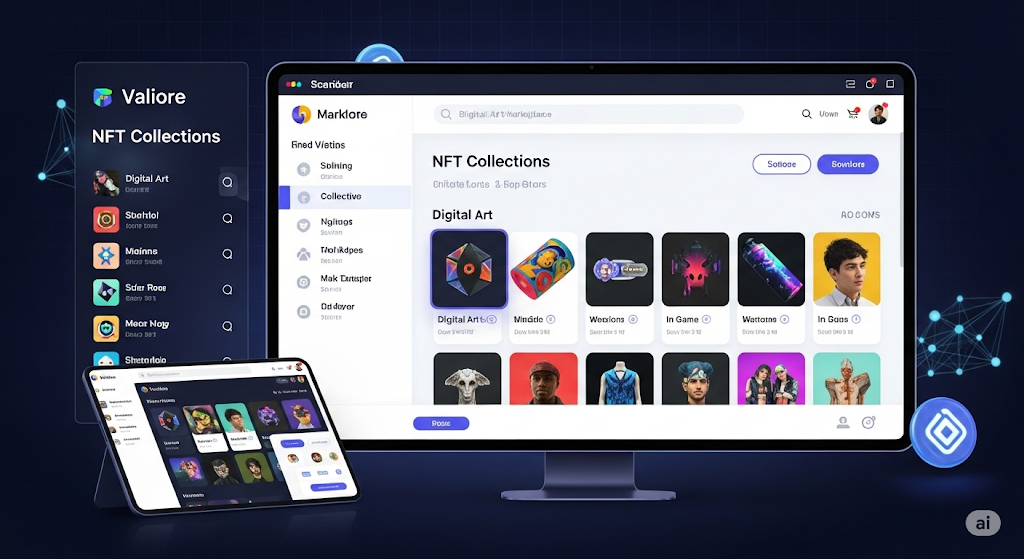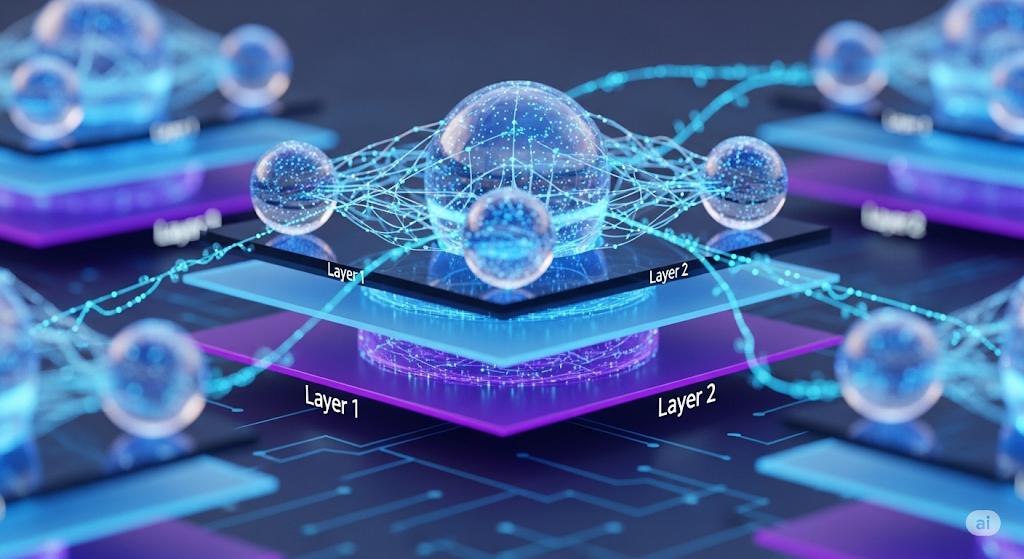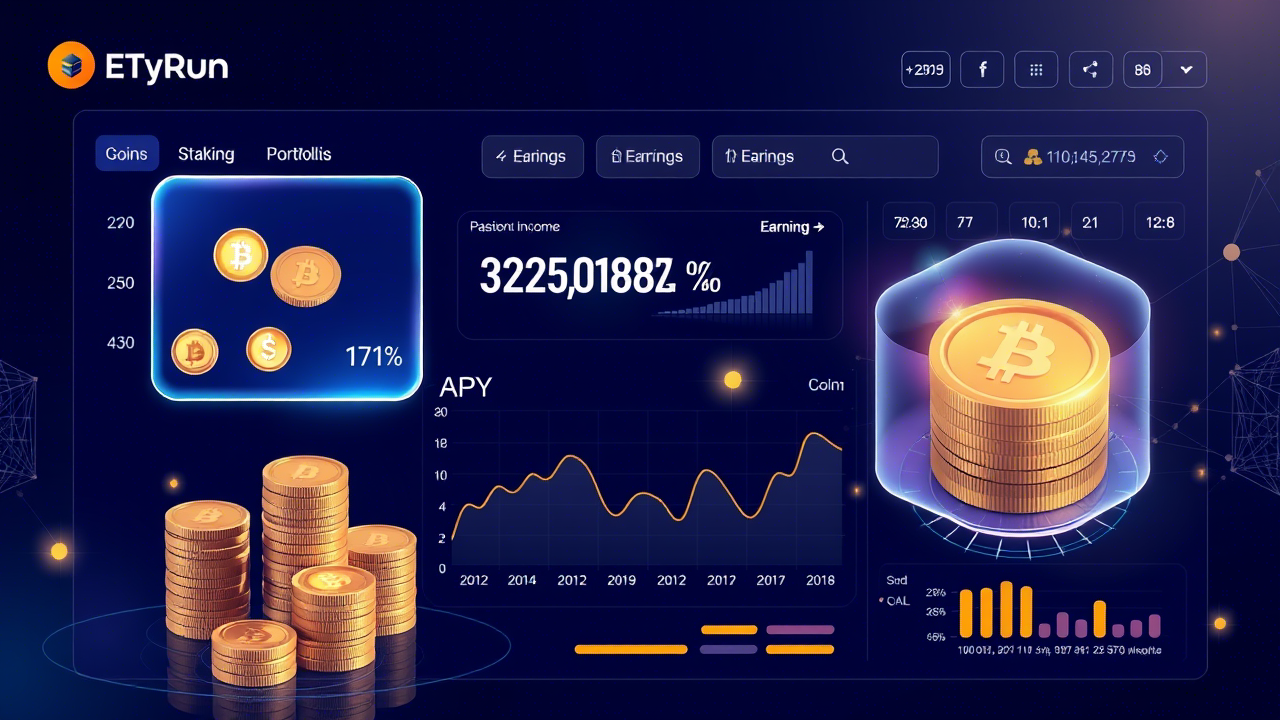The digital landscape is undergoing a revolutionary transformation, moving from centralized platforms controlled by tech giants to a decentralized ecosystem where users have unprecedented control over their data and digital assets. Web3 technology represents the next evolution of the internet, promising to democratize access to information and create new economic opportunities through blockchain innovation. This comprehensive guide explores how decentralized internet technologies are reshaping our digital future and what this means for investors, developers, and everyday users.
What is Web3 Technology?
Web3 technology refers to the third generation of internet services built on blockchain networks, smart contracts, and decentralized protocols. Unlike Web2, which relies on centralized platforms like Facebook, Google, and Amazon, Web3 operates on a peer-to-peer network where users maintain ownership of their data and digital assets. This fundamental shift from centralized to decentralized architecture eliminates intermediaries and creates trustless systems where transactions and interactions occur directly between participants, similar to how blockchain technology enables distributed ledger systems.
The core principle of Web3 technology revolves around decentralization, where no single entity controls the network or user data. Instead, blockchain networks distribute control across thousands of nodes worldwide, making the system more resilient, transparent, and censorship-resistant. This technology stack includes blockchain infrastructure, smart contracts, decentralized storage solutions, and token-based economies that incentivize participation and governance.
Web3 technology meaning extends beyond simple decentralization to encompass a fundamental reimagining of how we interact with digital services. It represents a paradigm shift from platforms extracting value from users to systems where users directly benefit from their participation and data contribution. This creates new economic models where digital ownership is verifiable, transferable, and programmable through smart contracts.
Web3 vs Traditional Internet: Understanding the Evolution
The evolution from Web1 to Web3 represents a journey from passive consumption to active participation and ownership. Web1 focused on static information sharing, Web2 introduced dynamic content creation and social interaction, while Web3 adds decentralized ownership and trustless value exchange. This progression reflects our growing understanding of digital rights and the importance of user sovereignty in the digital age.
Traditional internet architecture relies on centralized servers and databases controlled by corporations, creating single points of failure and control. Web3 blockchain technology distributes this infrastructure across decentralized networks, making systems more robust and giving users direct control over their digital presence. This shift reduces dependency on intermediaries and creates opportunities for direct peer-to-peer value exchange.
The economic models also differ significantly between traditional internet and Web3 systems. While Web2 platforms generate revenue by monetizing user data and attention, Web3 applications create value through token economies where users earn rewards for participation, governance, and content creation. This fundamental change in value distribution has profound implications for how we think about digital labor and content ownership, especially when considering cryptocurrency investment strategies in the Web3 ecosystem.
Core Components of Web3 Technology Stack
The Web3 technology stack consists of several interconnected layers that work together to create decentralized applications and services. The foundation layer includes blockchain networks like Ethereum, Polkadot, and Solana that provide the underlying infrastructure for smart contracts and decentralized applications. These networks ensure consensus, security, and immutability of transactions and data.
Smart contracts form the application layer, enabling programmable agreements that execute automatically when predefined conditions are met. These self-executing contracts eliminate the need for intermediaries and create trustless systems where participants can interact without knowing or trusting each other. Learning how to build automated blockchain smart contracts is essential for developers entering the Web3 space. Smart contracts power everything from decentralized finance protocols to non-fungible token marketplaces.
Decentralized storage solutions like IPFS (InterPlanetary File System) and Arweave provide alternatives to centralized cloud storage, ensuring data permanence and accessibility without relying on single providers. These systems distribute data across multiple nodes, making it virtually impossible for any single entity to control or censor information.
Web3 Applications: Real-World Implementation
Web3 applications span numerous industries and use cases, demonstrating the versatility and potential of decentralized technologies. Decentralized finance (DeFi) represents one of the most successful implementations, enabling peer-to-peer lending, trading, and yield farming without traditional financial intermediaries. These applications have processed billions of dollars in transactions while maintaining transparency and accessibility. For those interested in exploring this space, understanding DeFi crypto investment opportunities is crucial for maximizing returns in decentralized protocols.
Non-fungible tokens (NFTs) showcase another significant Web3 application, creating verifiable digital ownership for art, collectibles, and virtual assets. This technology enables creators to monetize their work directly while maintaining royalty rights through smart contracts. The NFT ecosystem has generated billions in trading volume and created new economic opportunities for artists and collectors.
Decentralized autonomous organizations (DAOs) represent a new form of governance where token holders collectively make decisions about project direction and resource allocation. These organizations operate transparently on blockchain networks, with all governance proposals and voting records publicly visible. DAOs have successfully managed treasuries worth hundreds of millions of dollars while demonstrating new models of collective decision-making.
Blockchain Innovation Driving Web3 Development
Blockchain innovation continues to push the boundaries of what’s possible in Web3 technology. Layer 2 scaling solutions like Polygon and Arbitrum have dramatically reduced transaction costs and increased throughput, making decentralized applications more accessible to mainstream users. These innovations address the scalability challenges that initially limited blockchain adoption.
Interoperability protocols are creating bridges between different blockchain networks, enabling seamless asset transfers and cross-chain applications. This development is crucial for Web3 adoption as it allows users to interact with multiple blockchain ecosystems without managing separate wallets or assets for each network.
Privacy-focused blockchain technologies are addressing concerns about transaction transparency by implementing zero-knowledge proofs and other cryptographic techniques. These innovations enable private transactions while maintaining the security and verifiability that make blockchain technology valuable.
Web3 Technology Examples in Practice
Gaming represents one of the most exciting Web3 technology examples, with play-to-earn models revolutionizing how players interact with virtual worlds. Games like Axie Infinity and The Sandbox have created economies where players own their in-game assets and can earn real income through gameplay. This model transforms gaming from pure entertainment to potential income sources.
Social media platforms built on Web3 principles are challenging traditional social networks by giving users ownership of their content and social graphs. Platforms like Lens Protocol and Farcaster enable users to take their followers and content across different applications, reducing platform lock-in and creating more competitive ecosystems.
Supply chain management applications demonstrate Web3’s potential for transparency and traceability. Companies are using blockchain technology to track products from origin to consumer, enabling verification of authenticity, ethical sourcing, and quality control. This application is particularly valuable in luxury goods, food safety, and pharmaceutical industries.
Understanding Web3 in Crypto Context
Web3 technology and cryptocurrency are intrinsically linked, with crypto tokens serving as the native assets that power decentralized applications and incentivize network participation. These tokens represent more than digital currency; they provide governance rights, access to services, and ownership stakes in protocol development.
The tokenization of assets and services creates new economic models where value flows directly to participants rather than intermediaries. This concept extends beyond financial assets to include intellectual property, digital art, and even time and attention. Web3 enables fractional ownership of expensive assets and creates liquid markets for previously illiquid investments.
Crypto wallets serve as the primary interface for Web3 interactions, storing not just digital assets but also identity credentials, access tokens, and interaction history. These wallets are evolving from simple storage tools to comprehensive Web3 browsers that enable seamless interaction with decentralized applications. Choosing the right crypto wallet for secure storage is fundamental to safely participating in the Web3 ecosystem.
How to Invest in Web3 Technology
Investing in Web3 technology requires understanding both the technological fundamentals and the various investment vehicles available. Direct cryptocurrency investments in platform tokens like Ethereum, Solana, and Polygon provide exposure to the underlying blockchain networks powering Web3 applications. These investments benefit from network growth and increased adoption of decentralized applications. Understanding the best cryptocurrency to invest in 2025 can help investors identify promising Web3 projects and blockchain platforms.
Web3 company stocks offer another investment avenue, with publicly traded companies like Coinbase, Block, and various mining companies providing exposure to the Web3 ecosystem. These traditional investment vehicles make Web3 accessible to investors who prefer regulated securities over direct cryptocurrency holdings.
Venture capital funds focused on Web3 startups provide access to early-stage investments in promising decentralized applications and infrastructure projects. These funds typically require significant minimum investments but offer professional management and diversification across multiple Web3 projects.
Web3 Technology Roadmap and Future Development
The Web3 technology roadmap focuses on solving current limitations while expanding functionality and adoption. Scalability improvements through layer 2 solutions and alternative consensus mechanisms aim to make decentralized applications competitive with traditional web services in terms of speed and cost.
User experience enhancements are crucial for mainstream adoption, with developers working on abstract wallet complexity and create more intuitive interfaces for Web3 applications. These improvements include social recovery mechanisms, gasless transactions, and seamless onboarding processes that don’t require deep technical knowledge.
Regulatory clarity and compliance tools are essential for Web3 technology to reach its full potential. Governments and regulatory bodies are developing frameworks for decentralized technologies, while projects are building compliance tools that enable businesses to operate within regulatory requirements while maintaining decentralization principles.
Web3 Technology Companies and Industry Leaders
Leading Web3 technology companies span various sectors, from infrastructure providers to application developers. Protocol labs, the company behind IPFS and Filecoin, focuses on decentralized storage solutions that form the backbone of Web3 data storage. Their innovations enable applications to store data permanently and accessibly without relying on centralized cloud providers.
ConsenSys, founded by Ethereum co-founder Joseph Lubin, provides development tools and infrastructure for Ethereum-based applications. Their MetaMask wallet has become the primary gateway for Web3 interactions, while their development suite enables businesses to build and deploy decentralized applications.
Chainlink has established itself as the leading oracle network, providing real-world data to smart contracts and enabling Web3 applications to interact with external systems. Their technology is crucial for many DeFi protocols and represents the bridge between blockchain networks and traditional data sources.
Web3 Jobs and Career Opportunities
The Web3 job market is expanding rapidly, with demand for skilled professionals far exceeding supply. Smart contract developers are particularly sought after, with expertise in Solidity and other blockchain programming languages commanding premium salaries. These roles involve creating the automated agreements that power decentralized applications.
Product managers with Web3 experience are crucial for bridging the gap between technical capabilities and user needs. These professionals must understand both traditional product management principles and the unique challenges of decentralized applications, including tokenomics, governance, and community building.
Marketing and community management roles in Web3 focus on building engaged communities around protocols and applications. These positions require understanding of token economics, governance mechanisms, and the cultural aspects of decentralized communities.
Web3 Tutorial: Getting Started Guide
Beginning your Web3 journey requires setting up a cryptocurrency wallet and acquiring your first digital assets. MetaMask provides an excellent starting point, offering a browser extension that connects to Ethereum and other compatible networks. This wallet serves as your identity and asset storage for Web3 interactions. New investors should also explore cryptocurrency investment for beginners to understand the fundamentals before diving into Web3 applications.
Exploring decentralized applications starts with simple interactions like token swaps on Uniswap or providing liquidity to earn rewards. These activities help you understand how Web3 applications work while generating potential returns on your cryptocurrency holdings. Start with small amounts to learn the mechanics without significant risk.
Joining Web3 communities through Discord servers, Twitter, and governance forums provides valuable learning opportunities and networking connections. These communities often share educational resources, investment opportunities, and early access to new applications and protocols.
Web3 Technology Mining and Validation
Web3 technology mining extends beyond traditional cryptocurrency mining to include various forms of network validation and maintenance. Proof-of-stake networks like Ethereum 2.0 enable users to earn rewards by staking their tokens to validate transactions and secure the network. This approach is more energy-efficient than proof-of-work mining while still providing decentralization.
Liquidity mining in DeFi protocols rewards users for providing capital to decentralized exchanges and lending platforms. These programs distribute governance tokens to participants, creating incentives for early adoption and network growth. Understanding these mechanisms is crucial for maximizing returns in Web3 ecosystems.
Content creation and curation mining rewards users for contributing valuable content to decentralized platforms. Projects like Hive and Steemit distribute tokens based on content quality and community engagement, creating new models for monetizing creativity and knowledge sharing.
AI Technology Integration in Web3
The integration of AI technology in Web3 creates powerful synergies between artificial intelligence and decentralized systems. AI models can be tokenized and traded on decentralized marketplaces, enabling developers to monetize their algorithms while providing users with access to sophisticated AI capabilities.
Decentralized AI training networks distribute the computational requirements for machine learning across multiple nodes, reducing costs and increasing accessibility. These networks can reward participants with tokens for contributing computing power, creating new economic incentives for AI development.
Privacy-preserving AI techniques enable model training on encrypted data without exposing sensitive information. This capability is particularly valuable in Web3 contexts where data privacy and user control are paramount concerns.
Web3 Technology Solutions for Businesses
Enterprise Web3 technology solutions address specific business needs while maintaining the benefits of decentralization. Supply chain transparency platforms enable companies to track products throughout their lifecycle, providing consumers with verifiable information about origin, quality, and ethical sourcing.
Decentralized identity solutions reduce the burden of managing customer credentials while giving users control over their personal information. These systems enable businesses to verify customer identities without storing sensitive data, reducing security risks and compliance requirements.
Tokenized loyalty programs create more engaging customer experiences while reducing the costs associated with traditional rewards systems. These programs can be integrated across multiple businesses, creating collaborative ecosystems that benefit all participants.
Web3 Course and Educational Resources
Comprehensive Web3 courses cover both technical and business aspects of decentralized technologies. University programs are increasingly offering blockchain and Web3 specializations, while online platforms provide accessible education for professionals looking to transition into the space.
Hands-on development bootcamps focus on practical skills needed to build Web3 applications. These intensive programs typically cover smart contract development, decentralized application architecture, and tokenomics design. Many bootcamps also provide job placement assistance and networking opportunities.
Community-driven educational initiatives create collaborative learning environments where participants can share knowledge and work on projects together. These programs often leverage the principles of Web3 to create decentralized education models where learners also contribute to the curriculum.
The Future of Decentralized Internet
The future of decentralized internet extends far beyond current applications to encompass a fundamental restructuring of how we interact with digital services. Virtual and augmented reality applications built on Web3 principles will create immersive experiences where users truly own their digital assets and identities across multiple virtual worlds.
Integration with Internet of Things (IoT) devices will enable new forms of machine-to-machine payments and automated services. Smart contracts can facilitate micropayments between devices, creating economic incentives for sharing resources and data in ways that benefit all participants.
Governance systems built on Web3 principles may eventually influence how we organize society itself, with blockchain-based voting and resource allocation systems providing more transparent and inclusive decision-making processes. These developments represent the long-term potential of decentralized technologies to create more equitable and efficient social systems.
External Links:
FAQ
What is Web3 technology?
Web3 technology is the third generation of internet services built on blockchain networks, smart contracts, and decentralized protocols that give users control over their data and digital assets.
What is a Web3 example?
A Web3 example is Uniswap, a decentralized exchange that allows users to trade cryptocurrencies directly without intermediaries, earning fees through liquidity provision.
What is the AI technology in Web3?
AI technology in Web3 includes tokenized AI models, decentralized AI training networks, and privacy-preserving machine learning that operates on blockchain infrastructure.
What is Web3 useful for?
Web3 is useful for creating decentralized applications, enabling digital asset ownership, facilitating peer-to-peer transactions, and building trustless systems without intermediaries.
How to invest in Web3?
You can invest in Web3 through cryptocurrency purchases, Web3 company stocks, venture capital funds, or by participating in decentralized finance protocols.
What are Web3 jobs?
Web3 jobs include smart contract developers, blockchain engineers, product managers, community managers, and various roles focused on building decentralized applications.
Final Thought
Web3 technology represents more than a technological upgrade; it embodies a fundamental shift toward user empowerment and digital sovereignty. As we move forward, the success of Web3 will depend on our ability to balance innovation with usability, ensuring that the benefits of decentralization are accessible to everyone, not just technical experts. The journey toward a truly decentralized internet is just beginning, and those who understand and participate in this transformation will be positioned to benefit from the new economic opportunities it creates.












Leave a Reply